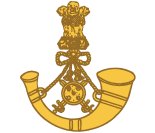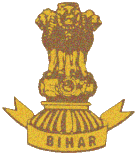
The Maratha Light Infantry is a light infantry regiment of the Indian Army. It traces its lineage to the Bombay Sepoys, raised in 1768, making it the most senior light infantry regiment in the Indian Army.

The Poona Horse is an armoured regiment in the Armoured Corps of the Indian Army. The regiment, known before independence as The Poona Horse, was raised as a regular cavalry regiment in the Bombay Presidency army of the East India Company. It was formed from the 3rd Regiment of Bombay Light Cavalry, raised in 1820, and the Poona Auxiliary Horse, raised about 1817–18. The latter unit was absorbed into the regular forces about 1860 and the two regiments later became the 33rd Queen Victoria's Own Light Cavalry and the 34th Prince Albert Victor's Own Poona Horse.

The Bihar Regiment is an Indian Army infantry regiment. It traces its origins back to the British Indian Army. The Bihar Regiment was formed in 1941 by regularising the 11th (Territorial) Battalion, the 19th Hyderabad Regiment, and raising new battalions. The Bihar Regimental Centre (BRC) is located at Danapur Cantonment, Patna, the second oldest cantonment of India. INS Vikramaditya, the Indian Navy's largest ship and one of its two aircraft carriers is affiliated to the Bihar Regiment, Indian Army's highly decorated and battle-hardened unit.

The 16th Light Cavalry is a regiment of the Armoured Corps, a primary combat arm of the Indian Army. Prior to India gaining independence from the British in 1947, it was a regular cavalry regiment of the British Indian Army. It was formed in 1776 and is the oldest armoured regiment raised in India. The 16th Light Cavalry saw service in a number of conflicts ranging from the Second Anglo-Mysore War in 1781 to World War II. It has a number of battle honours including "Punjab 1965" earned during the Indo-Pakistani War of 1965.
The Indian Army had no standby force ready in 1971 with the specific task of attacking East Pakistan, one of the many reasons why India did not immediately intervene after Pakistan launched Operation Searchlight in March 1971. Indian Army's Eastern Command was tasked with defending the northern and eastern borders and fighting the insurgencies in Nagaland, Mizoram and Naxalites in West Bengal at that time.
20 SATA Regiment, nicknamed the Alma Mater of Locators and The Originals, is a Surveillance and Target Acquisition (SATA) artillery regiment, which is part of the Regiment of Artillery of the Indian Army.
2 Medium Regiment is part of the Regiment of Artillery of the Indian Army.
79 Medium Regiment is part of the Regiment of Artillery of the Indian Army.
64 Field Regiment is part of the Regiment of Artillery of the Indian Army.
29 Air Defence Regiment (Samba) is an Air Defence regiment of the Indian Army.
22 Medium Regiment (Sittang and Yenangyaung) is part of the Regiment of Artillery of the Indian Army. It was raised in 1920 as 8 Pack Artillery Brigade.
The 194 Field Regiment is part of the Regiment of Artillery of the Indian Army.
101 Field Regiment is part of the Regiment of Artillery of the Indian Army.
90 Field Regiment is part of the Regiment of Artillery of the Indian Army.
94 Field Regiment is part of the Regiment of Artillery of the Indian Army.
65 Medium Regiment is part of the Regiment of Artillery of the Indian Army.
32 Field Regiment is part of the Regiment of Artillery of the Indian Army.
53 Medium Regiment is part of the Regiment of Artillery of the Indian Army.
81 Medium Regiment is part of the Regiment of Artillery of the Indian Army.
99 Field Regiment is part of the Regiment of Artillery of the Indian Army.




